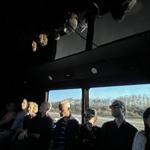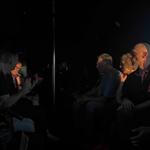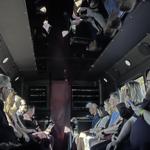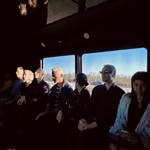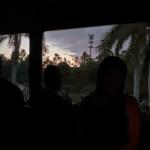Dark Ride
“Dark Ride” was a sound-art performance conceived by Rafael Lozano-Hemmer in 2016 for Laumeier Sculpture Park in St-Louis. The piece was initially intended as a "social sculpture" to remedy the lack of public transport that could bring visitors from segregated and disadvantaged areas of metropolitan St Louis, Ferguson, for example, to Laumeier Park, situated in the city's affluent suburbs. During the free ride, passengers in the darkened bus with multi-channel sound would listen to a geolocated and performed soundtrack that changed for every trip. The proposal was not accepted by the park administration and was shelved. Read the original proposal.
In 2024, the idea of reintroducing "Dark Ride" came about as a sound-art performance that would bring passengers from Miami to the city of Naples, where Rafael Lozano-Hemmer's sound-art retrospective "Obra Sonora" was being exhibited at the Baker Museum in the Artis-Naples complex. A suspicious-looking black party bus was rented, featuring tinted windows, benches seating 28 passengers, a dancing pole, a video wall, smoke machines, LED lights, lasers, and a 12-speaker 4-subwoofer sound system. For the 3-hour ride, all technologies were turned off except the sound system, a small mixing board, two microphones and a laptop computer.
Introduction to “Dark Ride” by Lozano-Hemmer. This included a run-through of the birth of atonal music, simultaneity in the work of Charles Ives, the composition of Ernst Toch for "spoken chorus,” and the vocal intermedia approach by Dick Higgins. The music programmed was:
Sonata 3: II. Allegro Agitato by Mexican pioneer Julián Carrillo, 1911, played by Jimena Giménez Cacho in "Julián Carrillo: Six Quasi-Sonatas in Quarter Tones", Quindecim Recordings, 2007.
Fugue aus der Geographie by Ernst Toch, 1930, played by Karl-Friedrich Beringer & Windsbach Boys Choir in "Eine kleine Melodie" Rondeau Production, 2002.
Requiem for Wagner the Criminal Mayor, 2 Excerpts, by Dick Higgins, 1962, from "New Wilderness Audiographics,” 8140A - Sound Poems, 1981.
Antimix, Part 1.
A playlist for “Dark Ride” curated by Christof Migone, who chose tracks "for the propulsive force that drives them, relentlessly, immersively, darkly, towards your ears." The music programmed was:
Seatbelt, Seatbelt by Charles Amirkhanian, 1973. From "Lexical Music", Arch Records, 1980. Curator notes: So, are you wearing yours? Does this vehicle even have them? This is a classic example of sound poetry, similar to Brion Gysin's permutations. It was influenced by Steve Reich's classic early works using tape loops to cause phasing (out of sync). The piece becomes increasingly intricate. A second voice joins, the stereo field gets a full workout. The layers accumulate. It builds up and then it decreases, and builds again. It then shifts to another grouping of words, 'cryptic quack chum bone'. The starting point is already more complex, too much so arguably, but we're in the same poetic territory, one where the systematic meets the absurd. A chorus (line) of ping pong inanities. Is this an outtake from Duck Soup?
Car Alarm, Turn Signal by Lia Kohl, featuring Ka Baird, from "Normal Sounds" 2024. Curator notes: If only alarms could be as pleasant as this. Even the incessant honks are bearable. Constant contrast between the musicalized car alarm and the field recording of a turn signal. There's a hint of car radio in the background. Toggling tones with a meditative tinge sets the ground for the gorgeous longing cello.
Study for Human-made Bird Calls and Microphone out a Moving Car Window by Raven Chacon, from "An Anthology of Chants Operations," 2020. Curator notes: The sonic equivalent of sticking your head out of the window on the highway. You can only express the exhilaration glee mixed with thrill and terror through high-pitched squeaks and squeals. Then the distorting wind takes over, and you're unsure how much more you can stand as the wind sucks the air out of your mouth. Breathing is not compatible with speed. Do any of the windows in this vehicle open?
Performance by Montreal-based poet Kaie Kellough, entitled “One Less Breath,” with an interactive filament bulb by Stephan Schulz. Introduced by Michael Nardone as follows: “There is a quote from Édouard Glissant’s “Cross-Cultural Poetics” that I often think about in relation to the works of Kaie Kellough: “Noise is essential to speech. Din is discourse.” Working across live performance, sound recordings, and many modes of writing (from poetry to novels to short stories), Kellough has articulated a discourse of his own – one that enlivens language, one that braids together the dissonances and harmonies that occur in its exchange. The perfection of his elocution and the clatter that emerges from his mouth and body in performance is truly something to behold. When I first moved to Montréal 15 years ago, I was struck how Kaie drew from all sorts of poetry threads and traditions, paying homage to them and learning from them, while always creating a work outside their spheres. At once, one might hear affinities with the great Caribbean tradition of breath and ritual (in the works of Kamau Brathwaite and M. NourbeSe Philip, for instance, amongst many others), from the global network of sound and concrete poetry of the past century, from musique concrète and sound art, as well as the sound system culture of the Caribbean and its diaspora communities. And yet, listen to his recorded works such as Creole Continuum or the more recent FYEAR group project, and you’ll experience the impression of these traditions that Kaie carries into a category all their own. I’ll draw attention to books like Magnetic Equator, winner of the esteemed Griffin Poetry Prize, the experimental novel Accordéon, and the collection of short stories Dominoes at the Crossroads, winner of the MacLennan Prize for Fiction – they are all great works, and wonderful examples of the embodied din that Kaie can bring into text- based work.Intermission, stop at the Miccosukee service station, Alexandra Vázquez explains that the Florida Seminoles are the only tribe in America never to have signed a peace treaty with the US Government.”
Antimix, Part 2.
Dark but Bright by Ana da Silva & Phew, on "Shouting out loud!", released 2018. Curator notes: Two voices, garbled, mangled, embedded in a rising ominous pulse. Eventually a beat fades in; there are also tidbits of feedback. The unintelligible pronouncements the breathy speech are immersed in a dense mix that drives resolutely forward even though it's going nowhere.
Spiritus Operis by Ka Baird, from their second solo album, "Respires" 2019. Curator notes: Pulse here is incessant; it's picking up speed, and it mimics the lines on the road. A voice moves across the stereo field, reminiscent of early Laurie Anderson in its playfulness but with perhaps an added hint of Diamanda Galas, subtly diabolical.
Music or Noise? by Matmos, from "Return to Archive" 2023. Curator notes: The perennial question. Always, the answer is music AND noise, noise AND music. Distinct but indissociable. Wails and yelps that you can dance to. Experimental, as in, this comes from a lab (aka studio) of ersatz scientists (Matmos) where being stuck in the hypothesis is always preferable to definitive proofs or theses.
Fonoteca Nacional de México sound archive performance improvisation by New-York based artist María Chávez. Introduced by Michael Nardone as follows: “Born in Lima, Peru, and based in New York City, Maria Chavez is an abstract turntablist, conceptual sound artist, and DJ. In her live performances and workshops, she explores improvisation and chance methods, archival recordings and multi-channel sound installations. Writing in Artforum, scholar of sonic avant-gardes Natilee Herren has described Chavez as “a bricoleur of intricate, cerebral, capricious sonic landscapes constructed through improvised sampling.” To speak of sonic art genealogies, as we have throughout the Dark Ride, it seems important to note the figure of Pauline Oliveros, who was a mentor to Chavez and whose listening practices left an indelible mark on Chavez’s approach to her works. Chavez is the author of a turntable manifesto called Of Technique: Chance Procedures on Turntable, which has circulated since 2012 in an underground network of sonic artists and experimental DJs. “Of Technique” has served as the basis of Chavez’s workshops, which she’s led over the last few years, and has inspired a whole new generation of sound artists. After a series of varying print editions, the book is, in my mind, due an important new edition so that his work and her methods can be more widely known. Today, on the Dark Ride, we’ll experience one side of Maria’s artistic production, which will focus on her composition and navigation of digitized archival sounds. Then, later on at the Baker, we’ll have the chance to hear Maria at the four turntable set-up – each turntable with a two-needle stylus! – where she will construct for us an 8-channel soundscape to hear within the context of Rafael’s Obra Sonora.”
Antimix, Part 3.
Imperceptible Perceptible by KMRU, originally released as an audio visual piece for the Issue Project Room, 2022. Curator notes: From the start you can probably tell that you're in for a long haul. It unfolds through its manifolds at a pace that levitates you above the tarmac. But it's too in your face to be ambient, it prods and nudges your ears. It doesn't let your listening stray or stay still; field recordings are interspersed. You keep asking yourself, 'Where am I?' Perhaps you are in that place, and in that moment, where perception is beside the point.
Speech by Sarah Hennies 2012-2014, released September 25, 2020. Curator notes: We are back where we started with Amirkhanian. In a car car car car car car car car car car car car.... (breath).... car car car car car car car car car car car car.... (breath). While that lone voice, unremittingly repeats 'car', slowly, the bass frequencies of the plosive 'c' as they hit the microphone's capsule are emphasized. Simultaneously, though at an even slower pace, the high frequencies are accentuated. The delicate tinny pings are soon the only thing that's left. The car is now a mere blip.
Final remarks on “Dark Ride” and arrival in Naples, cumbia music to arrive to the opening in a festive mood.
In 2024, the idea of reintroducing "Dark Ride" came about as a sound-art performance that would bring passengers from Miami to the city of Naples, where Rafael Lozano-Hemmer's sound-art retrospective "Obra Sonora" was being exhibited at the Baker Museum in the Artis-Naples complex. A suspicious-looking black party bus was rented, featuring tinted windows, benches seating 28 passengers, a dancing pole, a video wall, smoke machines, LED lights, lasers, and a 12-speaker 4-subwoofer sound system. For the 3-hour ride, all technologies were turned off except the sound system, a small mixing board, two microphones and a laptop computer.
Introduction to “Dark Ride” by Lozano-Hemmer. This included a run-through of the birth of atonal music, simultaneity in the work of Charles Ives, the composition of Ernst Toch for "spoken chorus,” and the vocal intermedia approach by Dick Higgins. The music programmed was:
Sonata 3: II. Allegro Agitato by Mexican pioneer Julián Carrillo, 1911, played by Jimena Giménez Cacho in "Julián Carrillo: Six Quasi-Sonatas in Quarter Tones", Quindecim Recordings, 2007.
Fugue aus der Geographie by Ernst Toch, 1930, played by Karl-Friedrich Beringer & Windsbach Boys Choir in "Eine kleine Melodie" Rondeau Production, 2002.
Requiem for Wagner the Criminal Mayor, 2 Excerpts, by Dick Higgins, 1962, from "New Wilderness Audiographics,” 8140A - Sound Poems, 1981.
Antimix, Part 1.
A playlist for “Dark Ride” curated by Christof Migone, who chose tracks "for the propulsive force that drives them, relentlessly, immersively, darkly, towards your ears." The music programmed was:
Seatbelt, Seatbelt by Charles Amirkhanian, 1973. From "Lexical Music", Arch Records, 1980. Curator notes: So, are you wearing yours? Does this vehicle even have them? This is a classic example of sound poetry, similar to Brion Gysin's permutations. It was influenced by Steve Reich's classic early works using tape loops to cause phasing (out of sync). The piece becomes increasingly intricate. A second voice joins, the stereo field gets a full workout. The layers accumulate. It builds up and then it decreases, and builds again. It then shifts to another grouping of words, 'cryptic quack chum bone'. The starting point is already more complex, too much so arguably, but we're in the same poetic territory, one where the systematic meets the absurd. A chorus (line) of ping pong inanities. Is this an outtake from Duck Soup?
Car Alarm, Turn Signal by Lia Kohl, featuring Ka Baird, from "Normal Sounds" 2024. Curator notes: If only alarms could be as pleasant as this. Even the incessant honks are bearable. Constant contrast between the musicalized car alarm and the field recording of a turn signal. There's a hint of car radio in the background. Toggling tones with a meditative tinge sets the ground for the gorgeous longing cello.
Study for Human-made Bird Calls and Microphone out a Moving Car Window by Raven Chacon, from "An Anthology of Chants Operations," 2020. Curator notes: The sonic equivalent of sticking your head out of the window on the highway. You can only express the exhilaration glee mixed with thrill and terror through high-pitched squeaks and squeals. Then the distorting wind takes over, and you're unsure how much more you can stand as the wind sucks the air out of your mouth. Breathing is not compatible with speed. Do any of the windows in this vehicle open?
Performance by Montreal-based poet Kaie Kellough, entitled “One Less Breath,” with an interactive filament bulb by Stephan Schulz. Introduced by Michael Nardone as follows: “There is a quote from Édouard Glissant’s “Cross-Cultural Poetics” that I often think about in relation to the works of Kaie Kellough: “Noise is essential to speech. Din is discourse.” Working across live performance, sound recordings, and many modes of writing (from poetry to novels to short stories), Kellough has articulated a discourse of his own – one that enlivens language, one that braids together the dissonances and harmonies that occur in its exchange. The perfection of his elocution and the clatter that emerges from his mouth and body in performance is truly something to behold. When I first moved to Montréal 15 years ago, I was struck how Kaie drew from all sorts of poetry threads and traditions, paying homage to them and learning from them, while always creating a work outside their spheres. At once, one might hear affinities with the great Caribbean tradition of breath and ritual (in the works of Kamau Brathwaite and M. NourbeSe Philip, for instance, amongst many others), from the global network of sound and concrete poetry of the past century, from musique concrète and sound art, as well as the sound system culture of the Caribbean and its diaspora communities. And yet, listen to his recorded works such as Creole Continuum or the more recent FYEAR group project, and you’ll experience the impression of these traditions that Kaie carries into a category all their own. I’ll draw attention to books like Magnetic Equator, winner of the esteemed Griffin Poetry Prize, the experimental novel Accordéon, and the collection of short stories Dominoes at the Crossroads, winner of the MacLennan Prize for Fiction – they are all great works, and wonderful examples of the embodied din that Kaie can bring into text- based work.Intermission, stop at the Miccosukee service station, Alexandra Vázquez explains that the Florida Seminoles are the only tribe in America never to have signed a peace treaty with the US Government.”
Antimix, Part 2.
Dark but Bright by Ana da Silva & Phew, on "Shouting out loud!", released 2018. Curator notes: Two voices, garbled, mangled, embedded in a rising ominous pulse. Eventually a beat fades in; there are also tidbits of feedback. The unintelligible pronouncements the breathy speech are immersed in a dense mix that drives resolutely forward even though it's going nowhere.
Spiritus Operis by Ka Baird, from their second solo album, "Respires" 2019. Curator notes: Pulse here is incessant; it's picking up speed, and it mimics the lines on the road. A voice moves across the stereo field, reminiscent of early Laurie Anderson in its playfulness but with perhaps an added hint of Diamanda Galas, subtly diabolical.
Music or Noise? by Matmos, from "Return to Archive" 2023. Curator notes: The perennial question. Always, the answer is music AND noise, noise AND music. Distinct but indissociable. Wails and yelps that you can dance to. Experimental, as in, this comes from a lab (aka studio) of ersatz scientists (Matmos) where being stuck in the hypothesis is always preferable to definitive proofs or theses.
Fonoteca Nacional de México sound archive performance improvisation by New-York based artist María Chávez. Introduced by Michael Nardone as follows: “Born in Lima, Peru, and based in New York City, Maria Chavez is an abstract turntablist, conceptual sound artist, and DJ. In her live performances and workshops, she explores improvisation and chance methods, archival recordings and multi-channel sound installations. Writing in Artforum, scholar of sonic avant-gardes Natilee Herren has described Chavez as “a bricoleur of intricate, cerebral, capricious sonic landscapes constructed through improvised sampling.” To speak of sonic art genealogies, as we have throughout the Dark Ride, it seems important to note the figure of Pauline Oliveros, who was a mentor to Chavez and whose listening practices left an indelible mark on Chavez’s approach to her works. Chavez is the author of a turntable manifesto called Of Technique: Chance Procedures on Turntable, which has circulated since 2012 in an underground network of sonic artists and experimental DJs. “Of Technique” has served as the basis of Chavez’s workshops, which she’s led over the last few years, and has inspired a whole new generation of sound artists. After a series of varying print editions, the book is, in my mind, due an important new edition so that his work and her methods can be more widely known. Today, on the Dark Ride, we’ll experience one side of Maria’s artistic production, which will focus on her composition and navigation of digitized archival sounds. Then, later on at the Baker, we’ll have the chance to hear Maria at the four turntable set-up – each turntable with a two-needle stylus! – where she will construct for us an 8-channel soundscape to hear within the context of Rafael’s Obra Sonora.”
Antimix, Part 3.
Imperceptible Perceptible by KMRU, originally released as an audio visual piece for the Issue Project Room, 2022. Curator notes: From the start you can probably tell that you're in for a long haul. It unfolds through its manifolds at a pace that levitates you above the tarmac. But it's too in your face to be ambient, it prods and nudges your ears. It doesn't let your listening stray or stay still; field recordings are interspersed. You keep asking yourself, 'Where am I?' Perhaps you are in that place, and in that moment, where perception is beside the point.
Speech by Sarah Hennies 2012-2014, released September 25, 2020. Curator notes: We are back where we started with Amirkhanian. In a car car car car car car car car car car car car.... (breath).... car car car car car car car car car car car car.... (breath). While that lone voice, unremittingly repeats 'car', slowly, the bass frequencies of the plosive 'c' as they hit the microphone's capsule are emphasized. Simultaneously, though at an even slower pace, the high frequencies are accentuated. The delicate tinny pings are soon the only thing that's left. The car is now a mere blip.
Final remarks on “Dark Ride” and arrival in Naples, cumbia music to arrive to the opening in a festive mood.
General info
Year of creation:
2024
No. 1
Technique:
The bus’s sound system, a small mixing board, two microphones, an LED Lightbulb and a laptop computer.
Additional info:
December 6th, 2024
Riding from Miami to Naples, FL
Riding from Miami to Naples, FL
Keywords:
Credits
- Concept and Curation: Rafael Lozano-Hemmer
- Curation: Michael Nardone
- Curation of Antimix Sound Art Content: Christof Migone
- Production Support: Karine Charbonneau, Libby Harrington, Daniela Silva, Gabriel Rizzotti, Stephan Schulz


